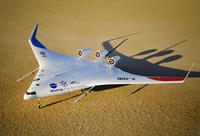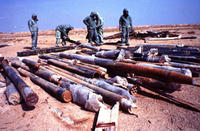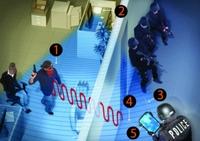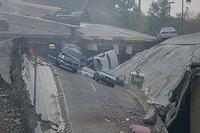-
Researchers move a step closer toward universal flu vaccine and therapies
Researchers describes three human antibodies that provide broad protection against Influenza B virus strains; the same team had previously reported finding broadly neutralizing antibodies against Influenza A strains; the work is a key step toward “universal” vaccine and therapies against flu
-
-
Futuristic blended wing body aircraft passes flight test

Boeing took another step forward in exploring a revolutionary concept — the blended wing body (BWB) — which one day could offer breakthroughs in flight; the X-48B, an unmanned research aircraft which is a scale model of a heavy-lift, subsonic vehicle that forgoes the conventional tube-and-wing airplane design in favor of a triangular aircraft that effectively merges the vehicle’s wing and body, proved during a flight test program that a BWB aircraft can be controlled as effectively as a conventional tube-and-wing aircraft during takeoffs and landings, as well as in other low-speed segments of the flight regime
-
-
Immediate, in-the-field identification of hazardous materials

Soldiers in war zones, and law enforcement and first responders on the scene will soon have the ability to collect and immediately analyze trace amounts of potentially dangerous chemical, explosive, or biological agents with the help of a surface swabbing device developed and prototyped by a Maine-based technology company with the help of the University of Maine researchers
-
-
New detection device for forensic and security applications
A new biological sampling and detection device could soon be used by first responders in the forensic and security sectors; the patented technology allows for rapid sampling of up to eight targets simultaneously, testing powder, liquids, or surfaces directly and has applications across the forensic and security areas
-
-
Wynyard Group takes New Zealand Police forensics solution global
Developed in 2007, New Zealand Police technology called EVE (Environment for Virtualized Evidence) allows enforcement officers rapidly to analyze seized electronic goods such as mobile phones, PCs, and other storage devices for evidence and intelligence
-
-
Improved disaster resilience is imperative for U.S: report
A new report from the National Academies says that it is essential for the United States to bolster resilience to natural and human-caused disasters, and that this will require complementary federal policies and locally driven actions that center on a national vision – a culture of resilience; improving resilience should be seen as a long-term process, but it can be coordinated around measurable short-term goals that will allow communities better to prepare and plan for, withstand, recover from, and adapt to adverse events
-
-
Seeing through walls with the help of laser systems
Inspired by the erratic behavior of photons zooming around and bouncing off objects and walls inside a room, researchers combined these bouncing photons with advanced optics to enable them to “see” what is hidden around the corner
-
-
UAVs with dexterous arms to help in infrastructure repair and disaster recovery
With current technology, most UAVs perform passive tasks such as surveillance and reconnaissance missions, tasks which are performed well above ground; researchers are interested in how UAVs might interact with objects at or near ground level; a UAV with dexterous arms could perform a wide range of active near-ground missions, from infrastructure repair and disaster recovery to border inspection and agricultural handling
-
-
Seeing through walls, clearly

Research and tests show, for the first time, the ability to use t passive WiFi radar for through-the-wall (TTW) detection of moving personnel – and do so covertly
-
-
New forensic tool automates RAM forensic investigations
New tool enables computer forensic investigators to analyze and make use of information contained in volatile memory; memory analysis produces important, case-relevant data for investigators that cannot be obtained from disk analysis, such as running applications, open files, and active network connections
-
-
Canadian company offers the first treatment to neutralize red mud

Red mud is the most significant waste product of the traditional Bayer process for aluminum production; the industry produces more than 100 million tons of red mud a year, of which less than 5 percent is be reused; the rest is stored in ponds and reservoirs, posing serious environmental and economic risk; on 4 October 2010, for example, a flood of toxic red mud devastated Hungary after a retaining dyke ruptured, causing an ecological disaster; Canadian company Orbite Aluminae offers a technology to tackle the aluminum industry’s most serious problem
-
-
Improving landmine detection – and air travel safety

It is estimated that there are about 110 million active landmines lurking underground in sixty-four countries across the globe; each year as many as 25,000 people, most of them civilians, are maimed or killed by landmines; the mines not only kill and maim, they can paralyze communities by limiting the use of land for farming and roads for trade; researchers offer a better way to detect landmines – a method which can also be used in airports to help thwart possible terrorist threats
-
-
Improving oil recovery, aiding environmental cleanup
Researchers have taken a new look at an old, but seldom-used technique developed by the petroleum industry to recover oil, and learned more about why it works, how it could be improved, and how it might be able to make a comeback not only in oil recovery but also environmental cleanup
-
-
New, affordable instant warnings of bridge collapse

The Federal Bureau of Transportation lists nearly 70,000 U.S. bridges as “structurally deficient,” requiring extra surveillance; in addition, more than 77,000 others are categorized as “obsolete” — exceeding their intended lifespan and carrying loads greater than they were designed to handle; researchers developed a new technology for monitoring these 150,000 aging U.S. highway bridges
-
-
A second look at off-shore use of vertical-axis wind turbines

Wind energy researchers are re-evaluating vertical axis wind turbines (VAWTs) to help solve some of the problems of generating energy from offshore breezes; though VAWTs have been around since the earliest days of wind energy research, VAWT architecture could transform offshore wind technology
-
More headlines
The long view
Autonomous Vehicle Technology Vulnerable to Road Object Spoofing and Vanishing Attacks
Researchers have demonstrated the potentially hazardous vulnerabilities associated with the technology called LiDAR, or Light Detection and Ranging, many autonomous vehicles use to navigate streets, roads and highways. The researchers have shown how to use lasers to fool LiDAR into “seeing” objects that are not present and missing those that are – deficiencies that can cause unwarranted and unsafe braking or collisions.
Tantalizing Method to Study Cyberdeterrence
Tantalus is unlike most war games because it is experimental instead of experiential — the immersive game differs by overlapping scientific rigor and quantitative assessment methods with the experimental sciences, and experimental war gaming provides insightful data for real-world cyberattacks.
Prototype Self-Service Screening System Unveiled
TSA and DHS S&T unveiled a prototype checkpoint technology, the self-service screening system, at Harry Reid International Airport (LAS) in Las Vegas, NV. The aim is to provide a near self-sufficient passenger screening process while enabling passengers to directly receive on-person alarm information and allow for the passenger self-resolution of those alarms.
Falling Space Debris: How High Is the Risk I'll Get Hit?
An International Space Station battery fell back to Earth and, luckily, splashed down harmlessly in the Atlantic. Should we have worried? Space debris reenters our atmosphere every week.
Testing Cutting-Edge Counter-Drone Technology
Drones have many positive applications, bad actors can use them for nefarious purposes. Two recent field demonstrations brought government, academia, and industry together to evaluate innovative counter-unmanned aircraft systems.
Strengthening the Grid’s ‘Backbone’ with Hydropower
Argonne-led studies investigate how hydropower could help add more clean energy to the grid, how it generates value as grids add more renewable energy, and how liner technology can improve hydropower efficiency.
The Tech Apocalypse Panic is Driven by AI Boosters, Military Tacticians, and Movies
From popular films like a War Games or The Terminator to a U.S. State Department-commissioned report on the security risk of weaponized AI, there has been a tremendous amount of hand wringing and nervousness about how so-called artificial intelligence might end up destroying the world. There is one easy way to avoid a lot of this and prevent a self-inflicted doomsday: don’t give computers the capability to launch devastating weapons.
The Tech Apocalypse Panic is Driven by AI Boosters, Military Tacticians, and Movies
From popular films like a War Games or The Terminator to a U.S. State Department-commissioned report on the security risk of weaponized AI, there has been a tremendous amount of hand wringing and nervousness about how so-called artificial intelligence might end up destroying the world. There is one easy way to avoid a lot of this and prevent a self-inflicted doomsday: don’t give computers the capability to launch devastating weapons.
